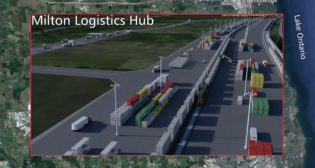
AAR: Big truck threat looms again
Written by Douglas John BowenLegislation designed to fix the nation’s crumbling transportation infrastructure will actually accelerate road and bridge damage and trigger an increase in taxpayer subsidies to the trucking industry, the Association of American Railroads said Tuesday, pointing to language in a House bill that allows for 20% heavier trucks and triple trailers.
“Americans don’t want 97,000 pound trucks or huge multi-trailers up to 120 feet long on our nation’s highways,” said AAR President and CEO Ed Hamberger. “Nor is it fair that even more of the public’s tax dollars will be used to pay for the road and bridge damage inflicted by massive trucks.”
Hamberger said heavy trucks at present only pay a fraction of the costs they inflict on taxpayers. AAR notes the Department of Transportation estimates that taxpayers currently subsidize nearly $2 billion of large truck damage. The most common truck on the road—an 80,000 pound five-axle single—pays just 80% of the maintenance costs it inflicts on roads, while a 97,000-pound six-axle single truck would pay only 50% of the damage it causes.
State and local governments are paying even more to repair damage caused by heavy trucks every year, and this amount could grow exponentially if truck sizes increase. According to the DOT, the additional cost of repairing bridge damage caused by raising truck weights to 97,000 pounds could be as much as $65 billion, AAR said.
“States, cities and taxpayers are already fiscally strapped and it makes no sense to burden them with paying for wear and tear inflicted by massive trucks,” Hamberger said. “Rather than increasing the taxpayer burden, this bill should ensure that all modes of transportation pay their fair share.” Hamberger noted the freight railroad industry pays for the maintenance and upkeep of the country’s rail system with private capital.
In addition, academic studies show that raising truck weights to 97,000 pounds from 80,000 could actually result in 8 million additional truckloads on America’s highways. “It’s not too hard to imagine what would happen to our roads if that is allowed to happen,” Hamberger said.



